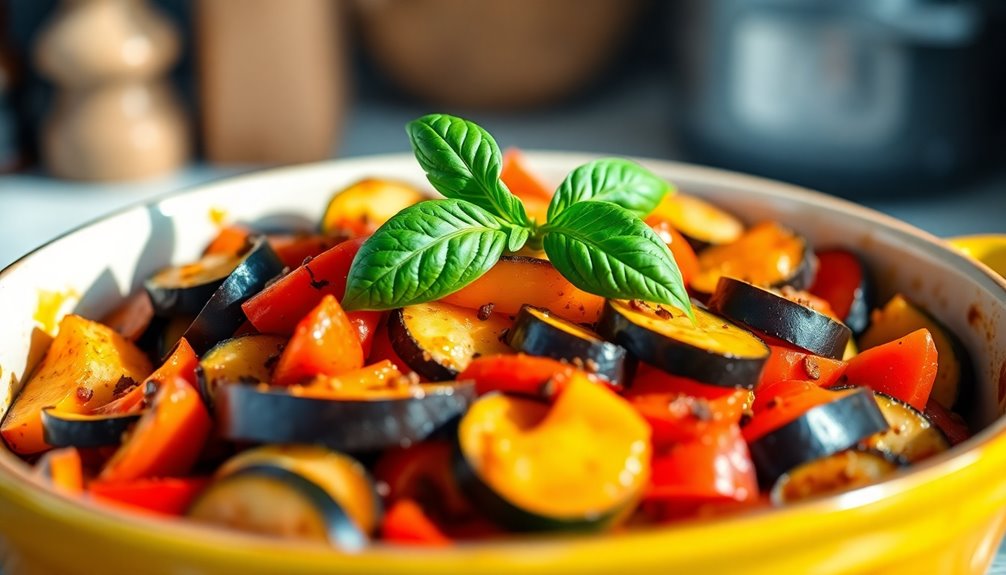One-pot ratatouille is a delightful blend of vibrant vegetables like tomatoes, zucchini, and eggplant, making it both hearty and packed with flavor. To start, wash and chop your fresh veggies, then layer them in a large pot. Sauté garlic and onions for sweetness before adding your colorful ingredients. Drizzle with olive oil, season generously, and let everything simmer to meld those delicious flavors. This dish is perfect for pairing with crusty bread or polenta, enhancing every bite. Feeling creative? There are countless variations and tips to explore that can elevate your ratatouille experience even further.
Key Takeaways
- Use a large pot to layer and cook all chopped vegetables like tomatoes, zucchini, and eggplant together for an easy, one-pot meal.
- Sauté onions and garlic first to enhance sweetness before adding the rest of the vegetables for a flavorful base.
- Season with fresh herbs like basil and thyme, along with olive oil, salt, and pepper to elevate the dish's flavor profile.
- Allow the ratatouille to simmer gently to meld flavors, ensuring vegetables retain their vibrant colors and textures.
- Serve with crusty bread or polenta for a complete meal that showcases the bounty of seasonal vegetables.
Ingredients Needed
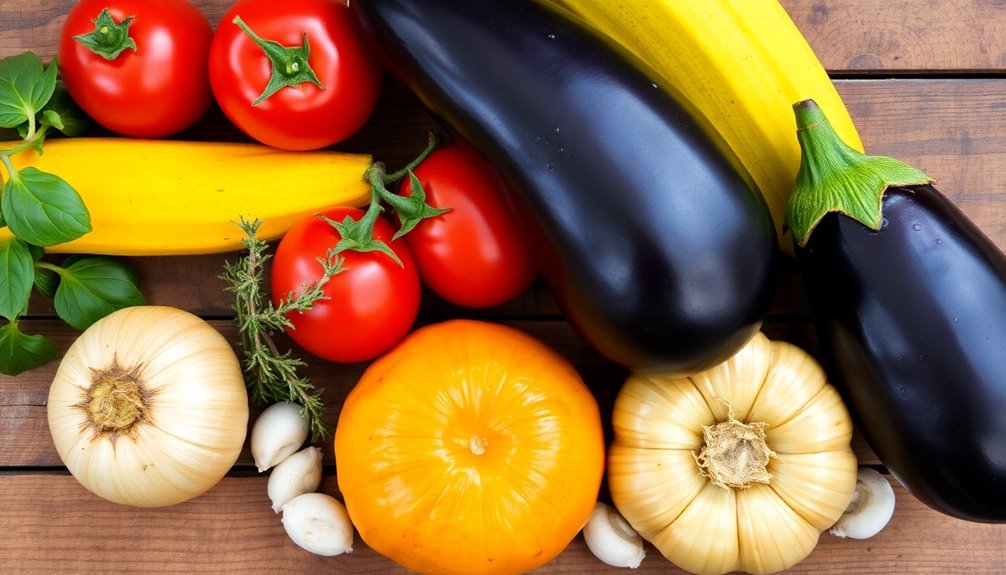
To whip up a delicious one-pot ratatouille, you'll need to gather a colorful array of fresh vegetables and herbs that bring this dish to life. Start with the classics: ripe tomatoes, zucchini, bell peppers, and eggplant. These vegetables not only offer vibrant colors but also create a delightful harmony of flavors. The sweetness of the tomatoes balances the earthiness of the eggplant, while the zucchini and peppers add a nice crunch.
Don't forget the aromatic herbs! Fresh basil, thyme, and parsley elevate your dish with their fragrant notes. They'll weave together the flavor combinations, making each bite a celebration of the garden's bounty. If you can't find fresh herbs, dried ones can work too—just remember to adjust the quantities since dried herbs are more potent.
When it comes to ingredient substitutions, feel free to get creative! If eggplant isn't your favorite, swap it for mushrooms or even carrots for a different texture.
You can also use any seasonal vegetables you have on hand. This dish is forgiving, encouraging you to play around with what's available in your kitchen. Want a little heat? Toss in some diced chili peppers or a sprinkle of red pepper flakes.
Preparation Steps
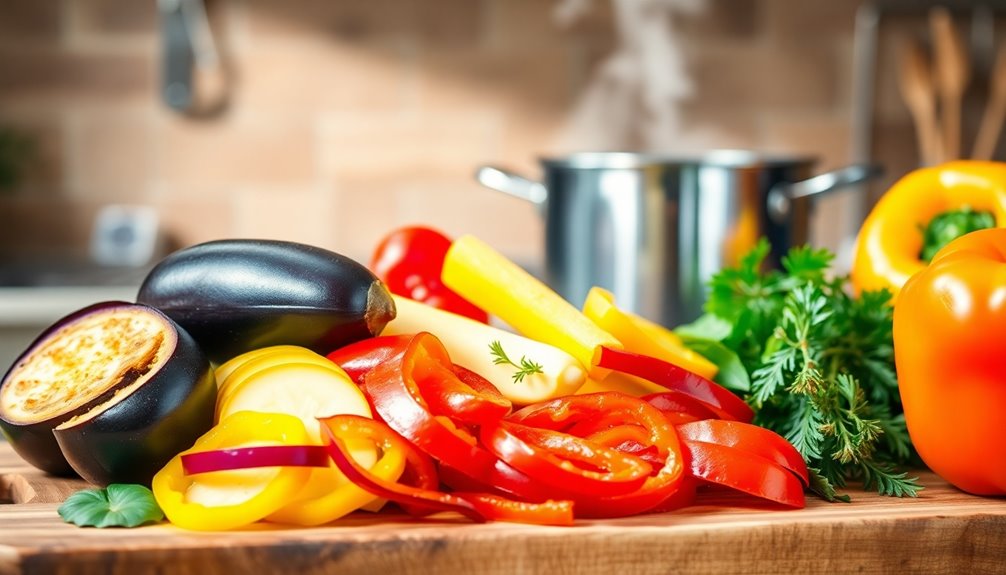
Gather your fresh ingredients and prepare to immerse yourself in the delightful world of one-pot ratatouille! Start by washing and chopping your vegetables: vibrant zucchini, eggplant, bell peppers, and ripe tomatoes. Aim for uniform pieces to guarantee they cook evenly, creating that perfect flavor combination that makes ratatouille so irresistible.
Next, don't forget to mince some garlic and chop fresh herbs like basil and thyme. These aromatic additions will elevate your dish, infusing it with warmth and character. For a time-saving tip, consider using pre-chopped veggies or frozen alternatives if you're pressed for time. They can still yield delicious results while keeping your prep time minimal.
Once your ingredients are prepped, get your favorite large pot or dutch oven ready. Layer in the vegetables, starting with the firmer ones like eggplant and zucchini, followed by bell peppers and tomatoes. This layering technique promotes even cooking and allows the flavors to meld beautifully.
Drizzle in a generous amount of olive oil, sprinkle with salt and pepper, and stir in your minced garlic and herbs. This step is essential, as it helps to build a rich foundation for the dish. Finally, cover the pot and let the magic happen as the vegetables soften and release their juices.
In just a short time, you'll have a comforting, hearty meal that not only nourishes your body but also warms your spirit. So gather your loved ones around the table and enjoy the fruits of your labor!
Cooking Techniques
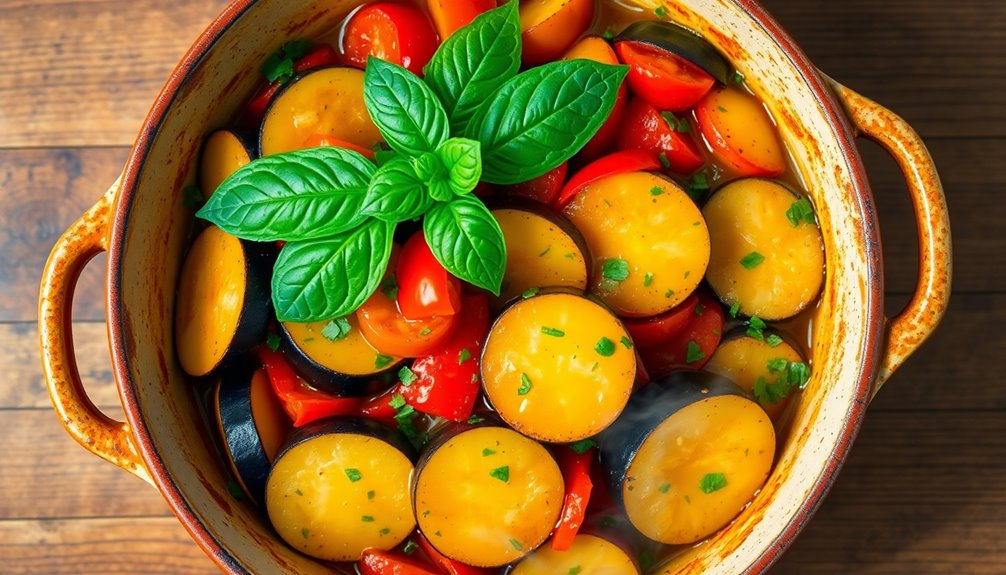
Cooking ratatouille involves a few straightforward yet effective techniques that elevate this dish from basic to extraordinary. First, you'll want to concentrate on sautéing your vegetables to bring out their natural sweetness and develop rich flavor profiles. Begin with onions and garlic, letting them soften and caramelize before adding the rest of your veggies—think zucchini, bell peppers, and eggplant. This step infuses the dish with depth and sets the foundation for a beautiful harmony of flavors.
Next, pay attention to cooking times. Each vegetable has its own ideal cooking duration, and knowing these will help you achieve that perfect texture. For example, eggplant needs a bit longer to become tender, while zucchini cooks quickly. By adding these ingredients in stages, you'll make sure that everything finishes cooking just right, preventing mushiness and maintaining some integrity in their shapes.
Don't forget to season as you go! A sprinkle of salt and fresh herbs like thyme or basil will enhance the flavors, prompting them to meld beautifully.
Once everything's combined, allow the ratatouille to simmer gently. This slow cooking technique lets the ingredients marry together, creating a comforting dish full of warmth and love.
Serving Suggestions
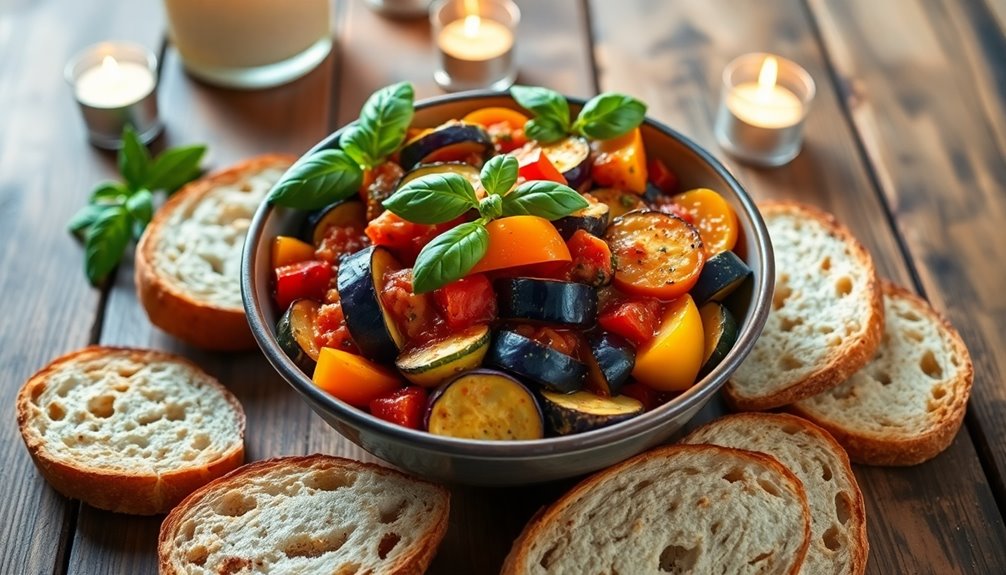
Ratatouille shines when served in a way that highlights its vibrant colors and flavors. To create an inviting presentation, consider placing your ratatouille in a beautiful, shallow dish, allowing the eye-catching layers of eggplant, zucchini, and bell peppers to steal the show. A sprinkle of fresh herbs like basil or parsley on top adds a burst of color and freshness that'll make your dish pop.
When it comes to side dishes, crusty bread is a must-have. It's perfect for soaking up the rich, savory sauce, and it invites everyone to gather around the table.
You might also serve your ratatouille alongside fluffy couscous or creamy polenta for a hearty, comforting meal. These sides not only complement the dish but also provide a lovely texture contrast.
Wine pairings elevate the experience even further. A light, crisp white wine, like a Sauvignon Blanc, enhances the fresh flavors of the vegetables, while a medium-bodied red, such as a Pinot Noir, can add depth and warmth to your meal.
Don't hesitate to ask your friends for their preferences; sharing a bottle of wine creates a sense of community and connection.
Variations to Try
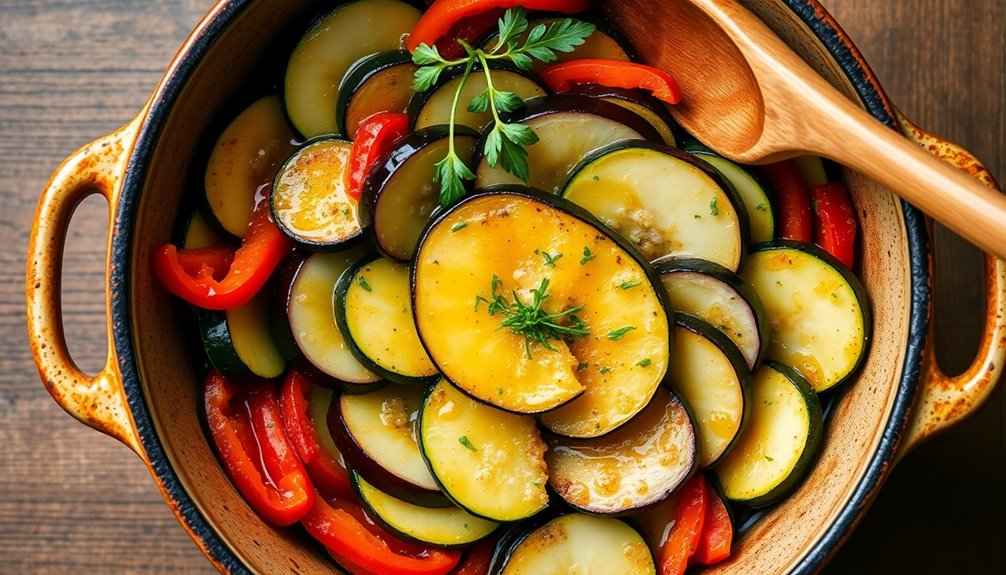
There are countless ways to put a unique spin on traditional ratatouille, allowing you to customize this classic dish to suit your taste. One of the most delightful ways to do this is by experimenting with flavorful additions. Consider stirring in some fresh basil or a pinch of red pepper flakes to give your ratatouille a zesty kick. If you're a cheese lover, try topping your dish with crumbled feta or a sprinkle of parmesan just before serving. These simple tweaks can elevate your ratatouille into a gourmet experience.
Seasonal twists are another fantastic way to keep your ratatouille exciting. In the summer, when zucchini and eggplant are at their peak, load your pot with these vibrant veggies. In the fall, swap in hearty root vegetables like parsnips or sweet potatoes to create a warm, comforting dish. You can also throw in seasonal herbs like thyme in the spring or sage in the winter to enhance those flavors.
Don't hesitate to get creative with your ratatouille! You might want to add a splash of balsamic vinegar for acidity or a handful of olives for a Mediterranean flair. Each variation brings its personality while maintaining the essence of this beloved dish.
Storage Tips
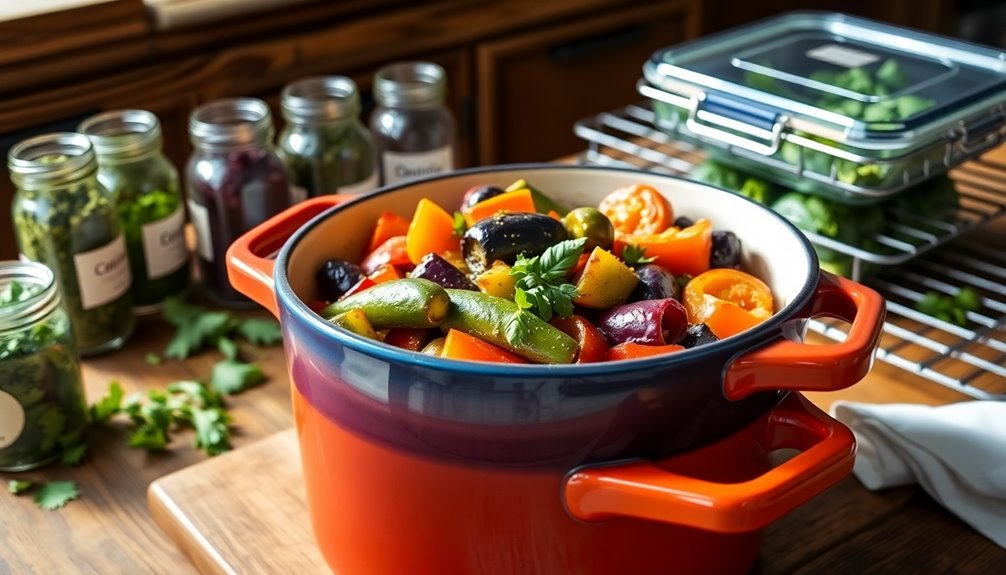
When you want to savor your delicious ratatouille beyond the dinner table, proper storage is key to preserving its vibrant flavors and textures. To keep your dish fresh and tasty, follow these simple food preservation tips:
- Cool Before Storing: Allow your ratatouille to cool to room temperature before transferring it to an airtight container. This prevents condensation, which can lead to sogginess and spoilage.
- Refrigerator Organization: Place your container in the fridge, ideally in a spot that maintains a consistent temperature. Aim for the middle shelf, as it's less prone to temperature fluctuations. Keep your ratatouille away from strong-smelling foods to avoid flavor contamination.
- Freezing for Longevity: If you want to extend the life of your ratatouille even further, consider freezing it. Portion it into smaller containers, so you can easily reheat just what you need. Make sure to label each container with the date, so you can enjoy your homemade dish at its best.
Nutritional Benefits
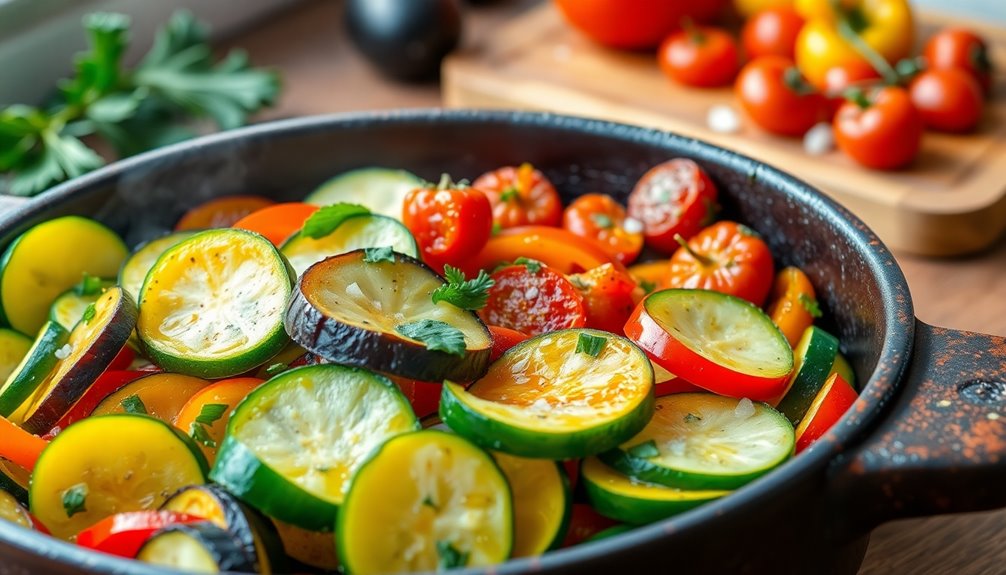
Packed with an array of colorful vegetables, one-pot ratatouille offers a wealth of nutritional benefits that can elevate your meals. This dish isn't just a feast for the eyes but a powerhouse of health benefits. Each ingredient—zucchini, eggplant, bell peppers, and tomatoes—provides essential vitamins and minerals. For instance, tomatoes are rich in antioxidants like lycopene, which may help reduce the risk of heart disease, while zucchini and eggplant are low in calories yet high in fiber, promoting digestive health.
When you whip up a pot of ratatouille, you're not just creating a delicious meal; you're embracing the culinary uses of seasonal vegetables that nourish both body and soul. The vibrant colors signify a variety of phytonutrients, which support your immune system and overall well-being. Plus, it's an excellent way to incorporate more plant-based foods into your diet, which many studies link to reduced chronic disease risk.
Ratatouille can be enjoyed in numerous ways, whether served warm as a main dish, chilled as a salad, or tossed with whole grains for a hearty side. This versatility makes it a perfect addition to any meal plan, allowing you to feel connected to the bounty of nature.
Pairing Recommendations
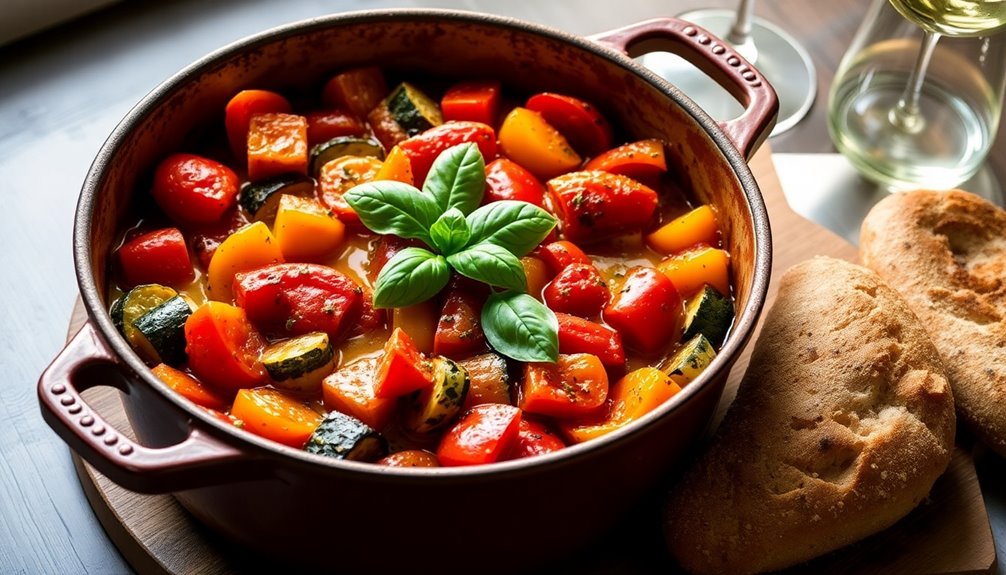
Ratatouille's vibrant medley of vegetables not only excites your palate but also pairs beautifully with a variety of accompaniments, enhancing its flavors and creating a well-rounded meal. As you prepare to serve this dish, consider these pairing recommendations that will elevate your dining experience:
- Wine Pairings: A light-bodied red wine, like a Pinot Noir or a fruity Rosé, complements the earthy flavors of the vegetables. If you prefer white wine, a crisp Sauvignon Blanc provides a invigorating contrast that balances the dish's richness.
- Side Dish Options: While ratatouille is delightful on its own, serving it alongside crusty French bread or creamy polenta can add a comforting touch. These side dishes soak up the delicious juices, making each bite even more satisfying.
- Herb Garnishes: Fresh herbs like basil, thyme, or parsley not only enhance the visual appeal but also amplify the dish's flavor combinations. A sprinkle of finely chopped herbs just before serving adds a burst of invigoration that ties everything together beautifully.
Common Mistakes to Avoid
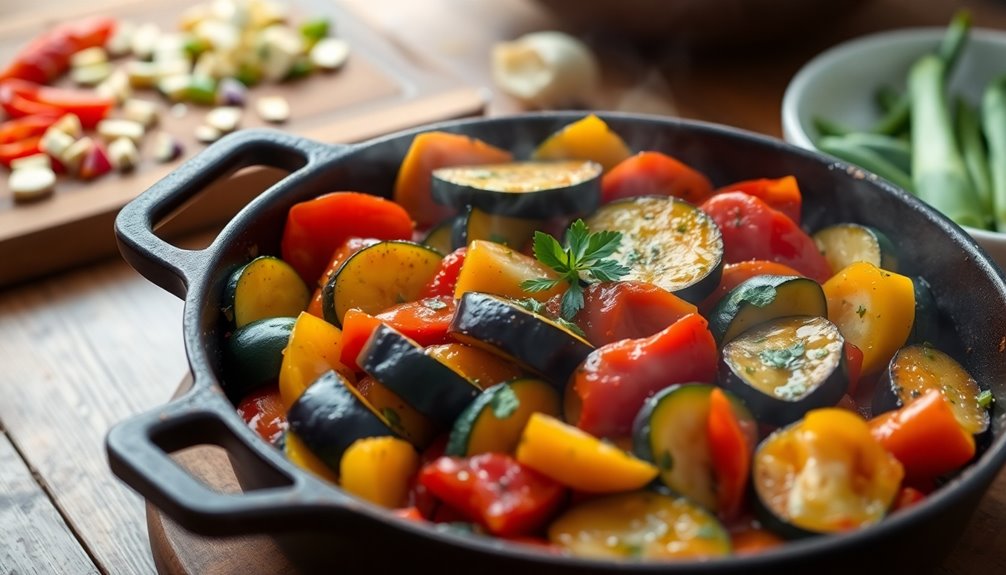
Many home cooks might overlook a few key details when preparing ratatouille, which can lead to a less-than-stellar dish.
One common pitfall is overcooking vegetables. You want your veggies to be tender yet maintain their vibrant colors and textures. If you let them simmer too long, they'll turn mushy and lose that beautiful presentation that makes ratatouille so appealing.
Another mistake isn't seasoning properly. Ratatouille is all about the fresh flavors of its ingredients, so don't be shy with your herbs and spices. A pinch of salt, a dash of pepper, and some fragrant herbs like thyme or basil can elevate your dish from bland to brilliant. Taste as you go, adjusting the seasoning to suit your palate.
Using canned ingredients can also dampen the authentic taste of your ratatouille. Fresh, high-quality vegetables truly make a difference, so opt for seasonal produce whenever possible. They'll infuse your dish with a depth of flavor that canned goods can't replicate.
Lastly, skipping the simmering process is a mistake you shouldn't make. This step allows the flavors to meld together beautifully, creating that rich, comforting essence you associate with this classic dish.
Frequently Asked Questions
Can I Use Frozen Vegetables for This Recipe?
Sure, you can use frozen vegetables, but keep in mind the fresh vs. frozen debate. Frozen veggies are convenient and still nutritious, but they mightn't deliver the same vibrant flavor and texture as fresh ones. If you're after that garden-fresh taste, fresh is the way to go.
However, if you're in a pinch, don't hesitate to reach for the frozen option—it'll still make a tasty dish you can enjoy with loved ones!
How Long Does Leftover Ratatouille Last in the Fridge?
Like a cherished novel waiting to be revisited, leftover ratatouille can linger in your fridge for about three to five days with proper storage. Make sure you place it in an airtight container to keep those vibrant flavors intact.
When you're ready to enjoy it again, you've got some great reheating options—microwave it for a quick fix or warm it on the stovetop to revive its comforting essence. Savor every bite!
Can I Add Meat to My Ratatouille?
Absolutely, you can add meat to your ratatouille! Consider options like chicken, sausage, or even ground beef for a hearty twist. Just sauté the meat first to infuse flavor before mixing it in with your veggies.
If you're leaning towards vegetarian alternatives, try adding lentils or chickpeas for protein. Whichever route you choose, you'll create a comforting dish that brings everyone together around the table, celebrating both flavors and good company!
Is Ratatouille Suitable for Vegetarians and Vegans?
Imagine a vibrant garden bursting with flavors; that's what ratatouille offers! It's a delightful dish packed with nutritional benefits, making it perfect for vegetarians and vegans.
The medley of vegetables shines in its simplicity, but you can also explore variations and additions like lentils or chickpeas for protein.
Whether you're hosting friends or enjoying a quiet evening, this dish creates a sense of belonging, uniting everyone over its warm, wholesome goodness.
What Type of Kitchenware Is Best for Making One-Pot Ratatouille?
When you're choosing kitchenware for a one-pot dish, consider stainless steel vs. cast iron. Stainless steel heats evenly, while cast iron retains heat beautifully, perfect for slow cooking.
Nonstick pans make cleanup a breeze, but ceramic options offer a stylish, non-toxic alternative.
Ultimately, it depends on your cooking style and preferences. Whichever you choose, you'll find that the right pot enhances your culinary experience, bringing you closer to the joy of cooking.
Conclusion
As the vibrant colors of your one-pot ratatouille twirl in the bowl, you're reminded that cooking can be a joyful celebration. Each bite bursts with the essence of sun-kissed vegetables, creating a symphony of flavors that warms the soul. With its simplicity and heartiness, this dish not only nourishes your body but also invites laughter and stories around the table. So, gather your loved ones and immerse in this delightful dish—it's more than a meal; it's a shared experience.

